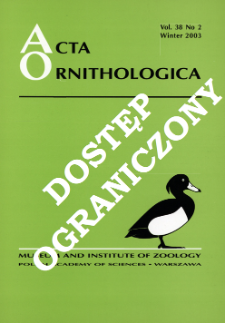- Search in all Repository
- Literature and maps
- Archeology
- Mills database
- Natural sciences
Advanced search
Advanced search
Advanced search
Advanced search
Advanced search

Object
Title: Male colour type and lifetime breeding success in the pied flycatcher Ficedula hypoleuca
Creator:
Ivankina, Elena Vasil'evna ; Grinkov, Vladimir G. ; Kerimov, Anvar Burhanovič (1955– )
Date issued/created:
Resource type:
Subtitle:
Acta Ornithologica, vol. 36, no. 1 ; Typ ubarwienia a sukces lęgowy u samców muchołówki żałobnej ; Male colour brightness and lifetime breeding success in pied flycatcher
Contributor:
Polska Akademia Nauk. Muzeum i Instytut Zoologii ; Meeting of the European Ornithologists' Union (2 ; 1999 ; Gdańsk)
Publisher:
Muzeum i Instytut Zoologii PAN
Place of publishing:
Description:
Referat wygłoszony na Second Meeting of the European Ornithologists' Union ; Bibliogr. s. 95 ; S. [91]-96 : il. ; 27 cm ; Streszcz. pol.
Type of object:
Abstract:
The lifetime breeding success of male Pied Flycatchers was evaluated over a period of nine years (1991-99). The breeding success of males recorded in at least two breeding seasons and nesting at least once in the study area was analysed. The lifespan number of offspring was positively and significantly correlated with longevity. The reproductive investment in the first year of life did not correspond with longevity, and hence non-breeding males in the first year did not compensate for the losses in fecundity. There were no differences in longevity between dark, intermediate and female-like coloured males. Darker males were less successful in their breeding attempts in the first year than paler birds. Breeding in the first year of life positively influenced the future number of fledglings, and the greater investment in reproduction in this year positively affected future brood size in dark males. Among males successfully breeding in the study area from their first season, dark males reared significantly more offspring during their lifetime, and in the first year of life, than paler ones. Nevertheless, in the total sample, lifetime brood size did not vary between differently coloured males, perhaps because dark males are more vulnerable to predators. The general difference between differently coloured males lay in how breeding efforts were distributed during life. Dark males can maximise reproductive investment from the first breeding year, while paler males increased average brood size in the following years of life only.
Relation:
Volume:
Issue:
Start page:
End page:
Detailed Resource Type:
Artykuł ; Materiały konferencyjne
Format:
Resource Identifier:
Source:
MiIZ PAN, patrz sygn. czas. P.257, Vol. 36, No ; MiIZ PAN, patrz sygn. czas. P.4568, Vol. 36, No 1 ; click here to follow the link
Language:
Rights:
Prawa zastrzeżone - dostęp ograniczony
Terms of use:
Digitizing institution:
Muzeum i Instytut Zoologii Polskiej Akademii Nauk
Original in:
Biblioteka Muzeum i Instytutu Zoologii PAN
Projects co-financed by:
Program Operacyjny Innowacyjna Gospodarka, lata 2010-2014, Priorytet 2. Infrastruktura strefy B + R ; Unia Europejska. Europejski Fundusz Rozwoju Regionalnego
Access:
Object collections:
- Digital Repository of Scientific Institutes > Partners' collections > Museum and Institute of Zoology PAS > Scientific Journals
- Digital Repository of Scientific Institutes > Partners' collections > Museum and Institute of Zoology PAS > MIZ PAN Publications > Acta Ornithologica
- Digital Repository of Scientific Institutes > Literature > Journals/Articles
Last modified:
Feb 4, 2025
In our library since:
May 23, 2014
Number of object content downloads / hits:
92
All available object's versions:
https://rcin.org.pl./publication/61304
Show description in RDF format:
Show description in RDFa format:
Show description in OAI-PMH format:
| Edition name | Date |
|---|---|
| Male colour type and lifetime breeding success in the pied flycatcher Ficedula hypoleuca / Ivankina, Elena Vasil'evna | Feb 4, 2025 |
Objects Similar
Alados, C. L. Escós, J.
Malizia, A. I. Bush, C.
Antczak, Marcin Hromada Martin Grzybek Jerzy Tryjanowski Piotr Polska Akademia Nauk. Muzeum i Instytut Zoologii
Bulatova, N. Searle, J. B. Bystrakova, N. Nadjafova, R. Shchipanov, N. Orlov, V.
Ries, Nancy
Sazhnev Alexey S. Budaev, Fyodor A.

 INSTYTUT ARCHEOLOGII I ETNOLOGII POLSKIEJ AKADEMII NAUK
INSTYTUT ARCHEOLOGII I ETNOLOGII POLSKIEJ AKADEMII NAUK
 INSTYTUT BADAŃ LITERACKICH POLSKIEJ AKADEMII NAUK
INSTYTUT BADAŃ LITERACKICH POLSKIEJ AKADEMII NAUK
 INSTYTUT BADAWCZY LEŚNICTWA
INSTYTUT BADAWCZY LEŚNICTWA
 INSTYTUT BIOLOGII DOŚWIADCZALNEJ IM. MARCELEGO NENCKIEGO POLSKIEJ AKADEMII NAUK
INSTYTUT BIOLOGII DOŚWIADCZALNEJ IM. MARCELEGO NENCKIEGO POLSKIEJ AKADEMII NAUK
 INSTYTUT BIOLOGII SSAKÓW POLSKIEJ AKADEMII NAUK
INSTYTUT BIOLOGII SSAKÓW POLSKIEJ AKADEMII NAUK
 INSTYTUT CHEMII FIZYCZNEJ PAN
INSTYTUT CHEMII FIZYCZNEJ PAN
 INSTYTUT CHEMII ORGANICZNEJ PAN
INSTYTUT CHEMII ORGANICZNEJ PAN
 INSTYTUT FILOZOFII I SOCJOLOGII PAN
INSTYTUT FILOZOFII I SOCJOLOGII PAN
 INSTYTUT GEOGRAFII I PRZESTRZENNEGO ZAGOSPODAROWANIA PAN
INSTYTUT GEOGRAFII I PRZESTRZENNEGO ZAGOSPODAROWANIA PAN
 INSTYTUT HISTORII im. TADEUSZA MANTEUFFLA POLSKIEJ AKADEMII NAUK
INSTYTUT HISTORII im. TADEUSZA MANTEUFFLA POLSKIEJ AKADEMII NAUK
 INSTYTUT JĘZYKA POLSKIEGO POLSKIEJ AKADEMII NAUK
INSTYTUT JĘZYKA POLSKIEGO POLSKIEJ AKADEMII NAUK
 INSTYTUT MATEMATYCZNY PAN
INSTYTUT MATEMATYCZNY PAN
 INSTYTUT MEDYCYNY DOŚWIADCZALNEJ I KLINICZNEJ IM.MIROSŁAWA MOSSAKOWSKIEGO POLSKIEJ AKADEMII NAUK
INSTYTUT MEDYCYNY DOŚWIADCZALNEJ I KLINICZNEJ IM.MIROSŁAWA MOSSAKOWSKIEGO POLSKIEJ AKADEMII NAUK
 INSTYTUT PODSTAWOWYCH PROBLEMÓW TECHNIKI PAN
INSTYTUT PODSTAWOWYCH PROBLEMÓW TECHNIKI PAN
 INSTYTUT SLAWISTYKI PAN
INSTYTUT SLAWISTYKI PAN
 SIEĆ BADAWCZA ŁUKASIEWICZ - INSTYTUT TECHNOLOGII MATERIAŁÓW ELEKTRONICZNYCH
SIEĆ BADAWCZA ŁUKASIEWICZ - INSTYTUT TECHNOLOGII MATERIAŁÓW ELEKTRONICZNYCH
 MUZEUM I INSTYTUT ZOOLOGII POLSKIEJ AKADEMII NAUK
MUZEUM I INSTYTUT ZOOLOGII POLSKIEJ AKADEMII NAUK
 INSTYTUT BADAŃ SYSTEMOWYCH PAN
INSTYTUT BADAŃ SYSTEMOWYCH PAN
 INSTYTUT BOTANIKI IM. WŁADYSŁAWA SZAFERA POLSKIEJ AKADEMII NAUK
INSTYTUT BOTANIKI IM. WŁADYSŁAWA SZAFERA POLSKIEJ AKADEMII NAUK


































